Related Research Articles
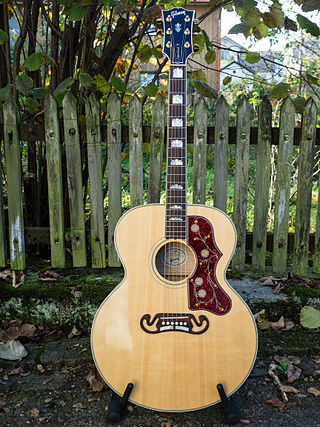
The steel-string acoustic guitar is a modern form of guitar that descends from the gut-strung Romantic guitar, but is strung with steel strings for a brighter, louder sound. Like the modern classical guitar, it is often referred to simply as an acoustic guitar, or sometimes as a folk guitar.

The bass guitar, electric bass or simply bass, is the lowest-pitched member of the guitar family. It is a plucked string instrument similar in appearance and construction to an electric or acoustic guitar, but with a longer neck and scale length, and typically four to six strings or courses. Since the mid-1950s, the bass guitar has largely replaced the double bass in popular music.

An electric guitar is a guitar that requires external amplification in order to be heard at typical performance volumes, unlike a standard acoustic guitar. It uses one or more pickups to convert the vibration of its strings into electrical signals, which ultimately are reproduced as sound by loudspeakers. The sound is sometimes shaped or electronically altered to achieve different timbres or tonal qualities from that of an acoustic guitar via amplifier settings or knobs on the guitar. Often, this is done through the use of effects such as reverb, distortion and "overdrive"; the latter is considered to be a key element of electric blues guitar music and jazz and rock guitar playing. Designs also exist combining attributes of the electric and acoustic guitars: the semi-acoustic and acoustic-electric guitars.

Jazz guitar may refer to either a type of electric guitar or a guitar playing style in jazz, using electric amplification to increase the volume of acoustic guitars.

Heritage Guitar is an American musical instruments manufacturer company based in Kalamazoo, Michigan. The company produces a range of electric guitars that includes hollow-body models.

John McLaughlin, frequently known as Mahavishnu John, is an English guitarist, bandleader, and composer. A pioneer of jazz fusion, his music combines elements of jazz with rock, world music, Indian classical music, Western classical music, flamenco, and blues. After contributing to several key British groups of the early 1960s, McLaughlin made Extrapolation, his first album as a bandleader, in 1969. He then moved to the U.S., where he played with drummer Tony Williams's group Lifetime and then with Miles Davis on his electric jazz fusion albums In a Silent Way, Bitches Brew, Jack Johnson, and On the Corner. His 1970s electric band, the Mahavishnu Orchestra, performed a technically virtuosic and complex style of music that fused electric jazz and rock with Indian influences.
The fingerboard is an important component of most stringed instruments. It is a thin, long strip of material, usually wood, that is laminated to the front of the neck of an instrument. The strings run over the fingerboard, between the nut and bridge. To play the instrument, a musician presses strings down to the fingerboard to change the vibrating length, changing the pitch. This is called stopping the strings. Depending on the instrument and the style of music, the musician may pluck, strum or bow one or more strings with the hand that is not fretting the notes. On some instruments, notes can be sounded by the fretting hand alone, such as with hammer ons, an electric guitar technique.

The seven-string guitar adds one additional string to the more common six-string guitar, commonly used to extend the bass range or also to extend the treble range.

The Gibson ES-335 is the world's first commercial semi-hollowbody electric guitar, sometimes known as semi-acoustic. Released by the Gibson Guitar Corporation as part of its ES series in 1958, it is neither fully hollow nor fully solid; instead, a solid maple wood block runs through the center of its body. The side "wings" formed by the two "cutaways" into its upper bouts are hollow, and the top has two violin-style f-holes over the hollow chambers. Since its release, Gibson has released numerous variations of and other models based on the design of the ES-335.

The Gibson EDS-1275 is a doubleneck Gibson electric guitar introduced in 1963 and still in production. Popularized and raised to iconic status by musicians such as John McLaughlin and Jimmy Page, it was called "the coolest guitar in rock."
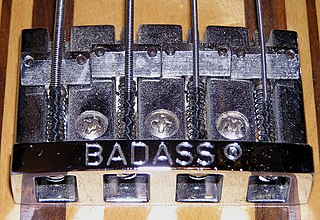
Badass was first trademarked by Leo Quan, a manufacturer of bridges for guitars and basses. Badass bridges feature individually adjustable saddles, which allows for "extremely accurate intonation adjustments." The Badass came on the market in the 1970s, and was made by entrepreneur and guitar repairman Glen Quan, of Marin County music store Bananas At Large and Leo Malliaris of Oakland's Leo's Music. The first Badass bridges were built from diecast zinc and were considered somewhat rough; later models were made from a high-density zinc alloy and more finely milled. Badass is currently owned and distributed by Allparts Music, a subsidiary of Morse Group.
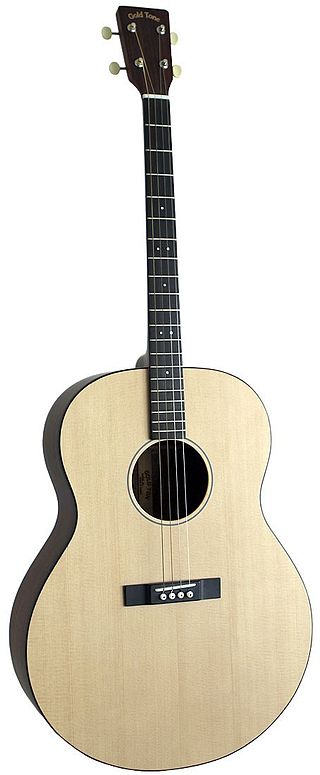
The tenor guitar or four-string guitar is a slightly smaller, four-string relative of the steel-string acoustic guitar or electric guitar. The instrument was initially developed in its acoustic form by Gibson and C.F. Martin so that players of the four-string tenor banjo could double on guitar.

The harp guitar is a guitar-based stringed instrument generally defined as a "guitar, in any of its accepted forms, with any number of additional unstopped strings that can accommodate individual plucking." The word "harp" is used in reference to its harp-like unstopped open strings. A harp guitar must have at least one unfretted string lying off the main fretboard, typically played as an open string.

Love Devotion Surrender is an album released in 1973 by guitarists Carlos Santana and John McLaughlin, with the backing of their respective bands, Santana and The Mahavishnu Orchestra. The album was inspired by the teachings of Sri Chinmoy and intended as a tribute to John Coltrane. It contains two Coltrane compositions, two McLaughlin songs, and a traditional gospel song arranged by Santana and McLaughlin. It was certified Gold in 1973.
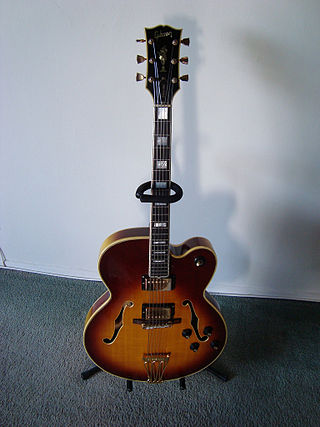
The Byrdland is an electric guitar made by Gibson. Its name derives from the names of guitarists Billy Byrd and Hank Garland for whom Gibson originally custom-built the guitar.
This is a list and description of the guitars and other equipment played by musician Stevie Ray Vaughan. Vaughan played a number of Fender Stratocasters throughout his career, one of which, a 1963 body and a late 1962 rosewood neck, became "the most famous battered Strat in rock history." He was notoriously hard on his guitars, and many of them required extensive periodic maintenance, as well as other equipment. He used a limited number of effect pedals, and favored Fender and Marshall amplification.

Michael Tobias Design (MTD) is a Kingston, New York-based manufacturer of electric bass guitars founded by luthier Michael Tobias in 1994.
The Fender Telecaster, colloquially known as the Tele, is an electric guitar produced by Fender. Together with its sister model the Esquire, it is the world's first mass-produced, commercially successful solid-body electric guitar. Its simple yet effective design and revolutionary sound broke ground and set trends in electric guitar manufacturing and popular music.
Jim Triggs is an American luthier, described as the "P.T. Barnum of guitar makers." He grew up in Kansas, where he taught himself how to build mandolins and violins. He began building guitars in the early 1980s, influenced by such luthiers as John D'Angelico, Elmer Stromberg, and Lloyd Loar, and went to work for Gibson Guitar Corporation in 1986 as one of the master luthiers in Gibson's custom shop. He is known mainly for archtop guitars and mandolins.
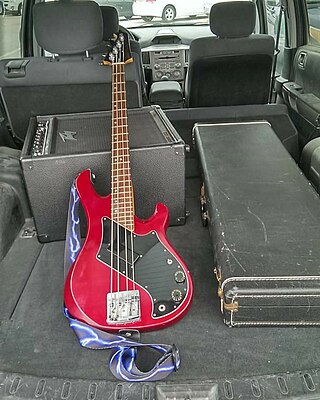
The Gibson Victory Bass was an electric bass guitar produced by Gibson Guitars from 1981 until 1986. It was a bass guitar variant of the Gibson Victory. It was not a successful model.
References
- ↑ Roberts, Jim (2003). American basses: an illustrated history & player's guide. Hal Leonard. p. 185. ISBN 978-0-87930-721-9.
- ↑ Erlewine, Dan (2007). Guitar Player Repair Guide. Hal Leonard. p. 37. ISBN 978-0-87930-921-3.
- ↑ Wechter, Abraham. "Bio" . Retrieved 2014-09-19.
- ↑ Alexander, Charles (2002). Masters of Jazz Guitar: The Story of the Players and Their Music. Hal Leonard. ISBN 978-0-87930-728-8.
- ↑ Milkowski, Bill (1998). Rockers, jazzbos & visionaries. Billboard Books. p. 176. ISBN 978-0-8230-7833-2.
- ↑ Stump, Paul (2000). Go ahead John: the music of John McLaughlin. SAF Publishing. p. 97. ISBN 978-0-946719-24-2.
- ↑ Wheeler, Tom (August 1978). "McLaughlin's Revolutionary Drone-String Guitar". Guitar Player . Archived from the original on 2002-04-24. Retrieved 2009-10-19.
- ↑ Stokes, W. Royal (2005). Growing up with jazz: twenty-four musicians talk about their lives and careers . Oxford UP. p. 156. ISBN 978-0-19-515927-1.
- ↑ "WECHTER GUITARS". Blue Book of Guitar Values. Blue Book Publications, Inc. Retrieved 6 May 2017.